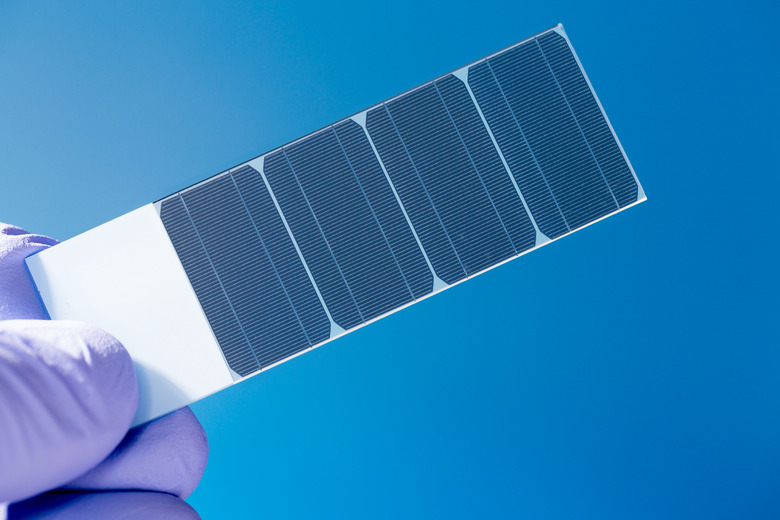How To Make A Solar Panel For A Science Project
A solar panel is an array of solar cells, and while you can construct a panel yourself with cells you purchase online, it's way cooler and more instructive to build your own cells out of found materials. With little more than a sheet of copper flashing and some salt water, you can generate a measurable electric current from sunlight. By itself, this type of cell doesn't generate much electricity, but if you were to build many of them and wire them in series, you could develop enough current to charge a battery or light a bulb.
Theory Behind the Copper Cell
Theory Behind the Copper Cell
When Heinrich Hertz discovered the photoelectric effect, he didn't have access to doped silicon chips, but he did have metal plates. One of the plates may have been copper that had oxidized by exposure to the atmosphere because cuprous oxide was one of the first materials that was observed to display this phenomenon. It's fairly easy to deposit a layer of cuprous oxide on a copper sheet. All you have to do is add heat.
Cuprous oxide is a semiconductor, and if you immerse the plate in saltwater and expose it to sunlight, electrons flow from the plate into the saltwater. Set a clean copper plate in the water to act as an anode, and the electrons flow to that. If you connect the two plates with a meter, the electrons flow back to the original plate through the meter, and the meter registers the electric current.
Preparing the Copper Plate
Preparing the Copper Plate
You'll need about half a square foot of copper flashing for this project, which you can find at most hardware stores. Cut it into two equal pieces, using tin snips. Wash the copper pieces with soap and water to remove grease, and then place one sheet on the burner of an electric stove. The piece should be large enough to cover the burner.
Turn on the heat to its highest setting and watch. The colors on the copper piece intensify, and then start to darken with a coating of cupric oxide. Wait for the copper to turn black, and then let it cook for another 30 minutes. Turn off the heat and let the copper cool on the burner.
As the plate cools, the copper and cupric oxide shrink at different rates, and the black coating begins to flake off. When the plate is completely cool, remove the plate and gently brush off all the flaking material. Underneath it is a red layer of cuprous oxide. Don't rub this off – this is the semi-conducting layer you need.
A Solar Cell In a Bottle
A Solar Cell In a Bottle
A clear plastic one-liter bottle makes a suitable container for your solar cell. Cut the bottle around the middle and remove the top so you have an open container. Bend the copper plate you heated into a semicircle and fit it inside the bottle so it rests against the side. The side that was facing up on the burner should be facing the outside of the bottle. Bend the copper plate you didn't heat into a similar shape and set it in the opposite side of the bottle. The plates shouldn't touch.
Mix two tablespoons of table salt into a glass containing about 2 cups of warm water and stir until the salt dissolves. Pour the salty water into the plastic bottle, filling it about 3/4 full. The tops of the metal plates should be above water so you can attach alligator clips. Your cell is now ready to generate electricity.
Take the cell outside and place it on a table so that the oxidized plate is facing the sun. Connect a meter to the plates with alligator clips and set the meter to register microamps of current. When the cell is in full sun, the meter should register between 33 and 50 microamps. Switch the meter to measure volts and you should notice a voltage of about 0.25 volts. To calculate the maximum power (P) the cell delivers, multiply the maximum current (I) by voltage (V) to get 0.00005 amps x .25 volts = 0.0000125 watts, or 12.5 microwatts. The formula expressing this relationship is P = V x I.
Wire Cells Together to Increase Power
Wire Cells Together to Increase Power
A solar panel is simply an array of solar cells wired in series. Although the cells on commercial panels are flat, it is possible to create a type of panel that consists of cells-in-a-bottle. Start with two bottle cells. Connect the anode on one of them, which is the clean copper plate, to the cathode of the other, which is the plate with the cuprous oxide deposit, using a wire with alligator clips. Connect the meter to the two plates that aren't connected. Since you double the voltage by wiring two cells in series, you have doubled the power of your array using the formula P = 2V x I. You can connect as many of these cells in series as you want. Each new cell increases the voltage by 0.25 volts.
Cite This Article
MLA
Deziel, Chris. "How To Make A Solar Panel For A Science Project" sciencing.com, https://www.sciencing.com/make-solar-panel-science-project-5916412/. 9 March 2018.
APA
Deziel, Chris. (2018, March 9). How To Make A Solar Panel For A Science Project. sciencing.com. Retrieved from https://www.sciencing.com/make-solar-panel-science-project-5916412/
Chicago
Deziel, Chris. How To Make A Solar Panel For A Science Project last modified August 30, 2022. https://www.sciencing.com/make-solar-panel-science-project-5916412/
